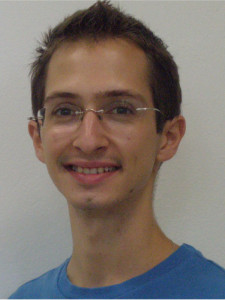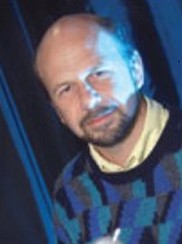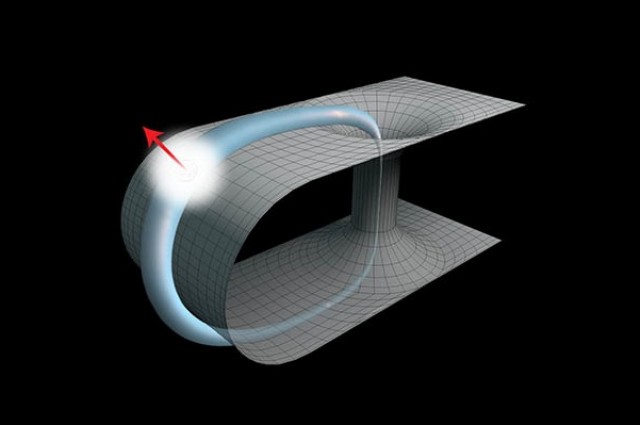Physicists at University of Queensland, Australia have simulated time travel using particles of light. The researchers achieved this by simulating the behavior of a single piece of light–a particle of energy–traveling on a closed timelike curve (CTC)–a closed path in space-time. The work may help to understand the longstanding problem of how time-travel could be possible in the quantum world and how the theory of quantum mechanics might change in the presence of closed timelike curves.
The work also shows how many effects, forbidden in standard quantum mechanics, may be possible inside a CTC and how light would behave differently depending on how it was created.

In the study, the research team simulated the behavior of a single photon that travels through a wormhole and interacts with its older self. This was achieved, PhD student Martin Ringbauer told The Speaker, by making use of a mathematical equivalence between two cases. In the first case, photon 1 “travels trough a wormhole into the past, then interacts with its older version.” In the second case, photon 2 “travels through normal space-time, but interacts with another photon that is trapped inside a CTC forever” (as shown in the illustration at top of the article). “Using the (fictitious second case) and simulating the behavior of photon 2, we were able to study the more relevant case 1,” said Ringbauer.
“We used single photons to do this,” said UQ Physics Professor Tim Ralph, “but the time-travel was simulated by using a second photon to play the part of the past incarnation of the time travelling photon.”
The paper, “Experimental Simulation of Closed Timelike Curves,” was completed by University of Queensland’s Dr Matthew Broome, Dr Casey Myers, Professor Andrew White, in addition to Professor Ralph and Martin Ringbauer, supported by the Australian Research Council Centre of Excellence for Engineered Quantum Systems and Centre of Excellence for Quantum Computation and Communication Technology, and was published in Nature Communications.
In the team’s press briefing, Ringbauer commented on the relationship between the theory of general relativity and another important–but conflicting–theory, quantum mechanics. Time travel is thought to potentially help understanding the gap between the two schools of thought.
“The question of time travel features at the interface between two of our most successful yet incompatible physical theories – Einstein’s general relativity and quantum mechanics,” said Ringbauer.
Time travel in the quantum world may avoid general relativity paradoxes such as the grandparents paradox–a timetraveller preventing his grandparents from meeting and so preventing his own time travel.
The authors of the study believe that such paradoxes can be resolved in a quantum regime, because a quantum model of closed timelike curves–such as traversable wormholes–can be formulated consistently with relativity”
Ringbauer explained the concept to The Speaker this way: “General relativity predicts the existence of closed timelike curves (e.g. by following a path through a wormhole that connects two different temporal locations in space-time). This would allow travel back in time. In the classical world this is unlikely to be possible, since it causes paradoxes, such as the grandfather paradox. In the quantum world, however, these paradoxes are resolved and time-travel can be formulated in a self-consistent way.”
Part of the reason time travel could be freed from such paradoxes in the quantum world is that the properties of quantum particles are “fuzzy” and “uncertain,” and therefore there is “wriggle room” to avoid inconsistencies in such situations, according to Professor Ralph.

Although Ralph said that there was no evidence that nature behaved differently than the laws of standard quantum mechanics, it had not been tested in vastly different environments, such as near black holes, where the extreme effects of general relativity play a role.
This is the value of the study, said Ralph. “Our study provides insights into where and how nature might behave differently from what our theories predict.”
“We see in our simulation (as was predicted in 1991),” Ringbauer stated, “how many effects become possible, which are forbidden in standard quantum mechanics. For example it is possible to perfectly distinguish different states of a quantum system, which are usually only partially distinguishable. This makes quantum cryptography breakable and violates Heisenberg’s uncertainty principle. We also show that photons behave differently, depending on how they were created in the first place.”

Hollywood has been doing this kind of simulation for many years. Whats new?
I wasn’t able to read their actual research paper (you have to pay to read that) so maybe they already thought of this- what if the ‘fuzziness’ of quantum particles is due to their actually going back in time through closed loops? since they couldnt occupy the same space we would see them exist as a cloud of potentials(?)…which we do. One thing I’ve never understood is do they return to a state like that after observing them ends, if not then perhaps the act of observation would have to somehow cut off the particles being able to ‘jump back’.
Snake Oil anyone?
Excellent explanation, very simple and to the point. Thanks for illustrating in a simple language the core of your fascinating experiment. This is the best result in time travel theories in a century. I am eager to buy the paper and read it. Thanks Tim.
I would believe such an assertion if wormholes were actually real. Wormholes have never been discovered and observed, nor has anyone ever been able to create one. They only exist in the minds of those who enjoy fantasy over reality.
How would a photon exit said time loop?
This email from Professor Timothy Ralph, which was unfortunately received just after publication, further explains the research. Thanks again, Tim.
Dear Day,
We simulated a photon that traveled to the past and was allowed to interact with its past self. We used single photons to do this, but the time-travel was simulated by using a second photon to play the part of the past incarnation of the time travelling photon. No worm-holes are required!
The reason this is interesting is because, although general relativity appears to allow for passages to the past (i.e. closed time-like curves created for example by wormholes), the passing of macroscopic objects, like us, through them seems to lead to paradoxes. For example, I go into the past and kill myself, but then I am not alive to go into the past to kill myself…etc. However, it was first shown by David Deutsch a bit over 20 years ago that microscopic particles described by quantum mechanics (like photons) can avoid these paradoxes and you can always find a consistent description of events. Roughly speaking, this occurs because of the uncertainty principle – we can never be exactly sure of all the properties of quantum particles and this uncertainty leaves enough “wiggle room” to always find a consistent evolution.
In our paper we experimentally show that if we prepare the state of the past incarnation of the time travelling photon in just the right way then indeed we get consistent evolutions in situations where we would expect paradoxes for classically described macroscopic objects. Although the evolutions are consistent, they are unusual – breaking rules that quantum mechanics would normally obey. This is another reason it is interesting. However, I emphasize it is a simulation – we “cheat” when we prepare the 2nd photon that represents the time traveler in the past.
All the best
Tim